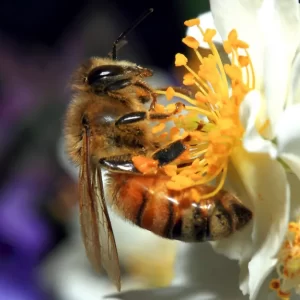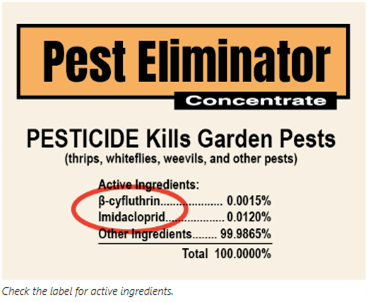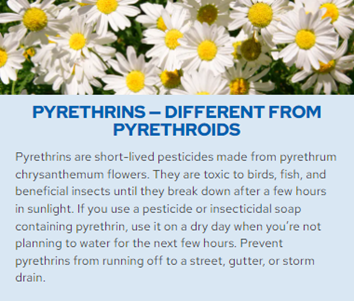
Learn how to manage pests while protecting the health of people, pets, and our environment with these tips from the City of Goleta Environmental Services Division.
Commonly used pesticides can be harmful to people and pets. They also pollute our water, air, and soil. While pesticides are used heavily in agriculture, more than half of California pesticide use is in urban and suburban areas—in and around our homes, schools, and businesses.
Threats to Wildlife and Water Quality
Commonly used pesticides poison birds, fish, and sensitive aquatic wildlife. In some locations, water contaminated with pesticides can migrate from creeks and surface waters into drinking water wells. We all need to do what we can to keep pesticides out of our creeks, streams, rivers, bays, and lakes.
Chlorpyrifos and diazinon, organophosphate pesticides, have been banned for residential use because they are so toxic to humans and the environment. These pesticides were either replaced or reformulated using other chemicals (“active ingredients”), that also cause water quality problems, including:
Pyrethroids
Pyrethroids are long-lived, synthetic pesticides that interfere with the function of an organism’s nervous system. They kill a wide variety of insect pests, including ants, cockroaches, and lawn grubs, but also earthworms and beneficial insects such as ladybugs and lacewings. When pyrethroids end up in our waters, they can kill crustaceans, aquatic insects, and fish.
Products containing pyrethroids have active ingredient names typically ending in “-thrin,” including permethrin, bifenthrin, cyfluthrin, beta-cyfluthrin, cypermethrin, deltamethrin, lambda-cyhalothrin, and tralomethrin. An exception is esfenvalerate.


Fipronil
This is another widely used insecticide for controlling ants, beetles, cockroaches, fleas, ticks, termites, mole crickets, thrips, rootworms, weevils, and other insects. It is associated with bee colony collapse disorder. Fipronil is toxic to aquatic life, and to rabbits and ground-feeding birds such as chickens and turkeys.
Imidacloprid
One of the most widely used pesticide in the world, imidacloprid is a neonicotinoid pesticide also linked to honey bee colony collapse disorder. In January 2013, the European Food Safety Authority stated that neonicotinoids pose an unacceptably high risk to bees. Many local garden centers have taken neonicotinoid pesticides off their shelves voluntarily because of the current honey bee crisis.
Malathion and Carbaryl (Sevin)
These pesticides are water-soluble—which means that rain and over-watering can easily cause them to run off lawns and gardens, into storm drains and on to local creeks, bays, and the ocean. They are twice as toxic in salt water as in fresh water. Both are toxic to honey bees and other pollinators.
Managing Pests While Protecting People, Pets and the Environment
- When you apply pesticides, you’re treating the symptom, rather than the cause of pest problems. Physical barriers (window screens and caulking to keep pests out), biological controls (encouraging beneficial insects), and cultural controls (keeping a clean house and a healthy garden that attracts beneficial insects) are always preferable to pesticide use. In situations where a pesticide is necessary, the best products for the environment are less toxic, less persistent, and target pests — not beneficial insects.
- Follow the suggestions on pest prevention and less-toxic pest control in the Our Water Our World fact sheet series found on this website and in participating stores
- Find detailed information on pests and integrated pest management (IPM) approaches at ucanr.edu.
Find more information on Pesticides and Water Pollution in our OWOW brochures in English and Spanish.
The City of Goleta along with the Cities of Buellton, Carpinteria, Solvang, Santa Barbara, Santa Maria, and the County of Santa Barbara have partnered with the OWOW organization to promote the use of less-toxic products in an effort to reduce pesticide pollution in our communities. By reducing pesticide use and the use of less-toxic products around the home, you can help reduce pesticides and other pollutants such as herbicides and fertilizers from being picked up while watering or when it rains and transported to the nearest storm drain inlet and into our waterways. The OWOW website is a great resource for finding less-toxic products to use around your home or garden.
Images courtesy of Our Water Our World

